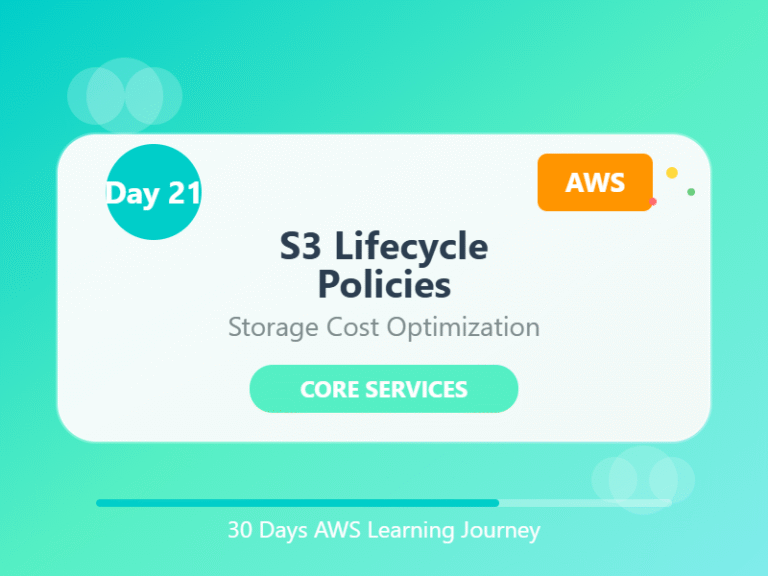📦 Day 21: S3 Lifecycle Policies – Automate Data Management in AWS
Category: AWS Storage
Goal: Learn how to automatically move or delete data in S3 based on rules.
🧠 What You’ll Learn Today:
- What S3 Lifecycle Policies are
- How to set up lifecycle rules
- Use cases to save storage costs
- Key terms: Transition, Expiration, Storage Classes
🗂️ 1. What Are Lifecycle Policies in S3?
Lifecycle policies help you automate the movement or deletion of objects stored in S3.
➡️ You can set rules like:
- Move data to cheaper storage after 30 days
- Delete files after 90 days
This helps in saving money and managing storage smartly.
🔑 2. Key Terms to Know
| Term | Meaning |
|---|---|
| Transition | Move objects to a different storage class (like S3 Standard → S3 Glacier) |
| Expiration | Automatically delete objects after a set number of days |
| Storage Class | Type of S3 storage (Standard, IA, Glacier, Deep Archive, etc.) |
🔄 3. Example Lifecycle Rule
📝 Rule:
- Files older than 30 days → move to S3 Infrequent Access (IA)
- Files older than 90 days → move to S3 Glacier
- Files older than 365 days → delete
🚀 This saves costs by using cheaper storage for older data.
🛠️ 4. How to Set It Up
- Go to your S3 bucket
- Click on Management tab
- Choose “Create lifecycle rule”
- Define:
- Rule name
- Scope (all objects or specific prefix/tags)
- Transitions
- Expiration
- Review and create
🔒 Tip: Lifecycle rules are non-destructive during testing — you can use them in a limited scope first.
✅ 5. Real-World Use Cases
- Auto-archive logs after 30 days
- Delete old backups after 1 year
- Move rarely accessed reports to Glacier
- Clean up temporary files
🧠 End of the Day Notes:
💡 Lifecycle policies = “set it and forget it” for managing your S3 data.
💸 They help you reduce costs without deleting important files too early.
📊 Always analyze your usage and access patterns before applying transitions.
🔁 Navigate the Series:
⬅️ Day 20: Backup & Recovery on AWS
➡️Day 22: Static Website Hosting on S3 – Host Websites the Easy Way


